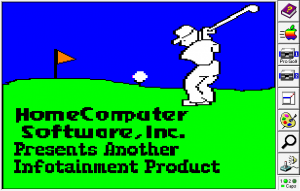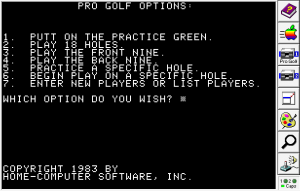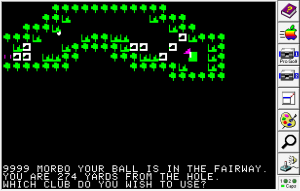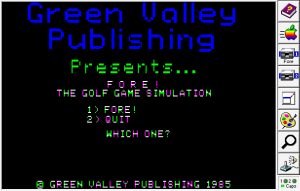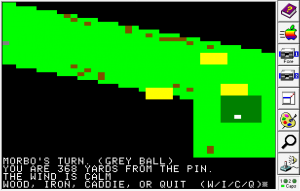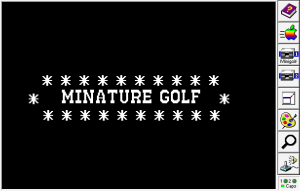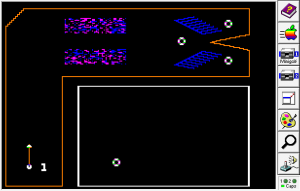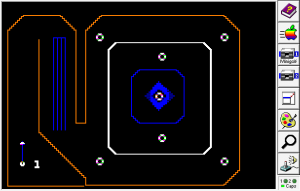Ah, the Apple II. That good old beast of a computer built by Steve Wozniak when Apple was just a wee company. I never owned one of these, but my elementary school had about a dozen of them back in the early 80s. From them, I learned the joys of waiting your turn, “no, we aren’t going to be playing games”, “yes magenta is a real colour” and “Bank Street Writer is going to replace all of the world’s typewriters one day”. I also learned how to draw shitty pictures of Garfield (the cartoon cat, not the US president) on the screen using Applesoft BASIC.
Someone did manage to sneak a game called “Gorgon” through. It’s a knockoff of Defender with a bit of the Star-Trek-Enterprise-Shoots-Satellites thrown in.
But I’ve never cared for the Apple II’s admittedly vast collection of games because, lets face it, this computer sucks for games. The sound is about as bad as the Atari 2600 and the graphics are not much better. The fact that Apple was able to extend the life of the Apple II product line as long as they did is more a tribute to Steve Jobs’ salesmanship than anything else. So how do you think golf games on this box will turn out?
The first one I tried is called “Pro Golf”, and it came out in 1983. Put away that joystick, you! Silly gamer, wanting to control a quasi-realistic simulation of a golfer swinging at a golf ball on a golf course.
Sadly, these are the most colourful and visually stunning parts of the game. They’re over in about five seconds.
A lot of Apple II games have menus like this. It was far easier to code the text to appear like this…
And here we are in the middle of the actual game. This is basically a golf RPG. All of the factors that might influence your shot get entered as answers to questions you are asked before you make that shot. Which club? What strength? Choose your aim.
That last part is what made me stop playing. As fleetingly interesting as it was to play this golf RPG, the aiming system is way too slow. For aiming a shot, an arrow appears on the screen. You press and hold L to rotate the arrow one way, and R the other way. This becomes tedious really fast, especially if you overshoot the hole and have to swing the arrow all the way around.
So I didn’t have a lot of fun with this game. I know that the Apple II can’t handle fast action games that are heavy on sprites and graphics, but there has to at lease be a decent golf game made for it. Let’s keep looking.
“Fore!”, 1985
This is looking about the same so far. And after reading the instructions, I confirm that yes, this too is a keyboard-input golf RPG.
But “Fore!” has much better controls and much better graphics than “Pro Golf”. That grey rectangle is the ball. Those brown rectangles are (I suppose) bushes and trees. The yellow rectangles are sant traps and the big dark green rectangle is the putting green. There’s no stupid aiming arrow that takes a half-an-eternity to move with this one, rather aiming is accomplished by entering a degree numeral. 0 degrees will fire the ball up (as in North), 90 will fire it right, 180 down, 270 left. You can enter any integer in between too.
You can also choose any iron or wood club, and they will make the ball travel different distances accordingly. The last thing you enter is the strength of your swing, from 1 to 100%. But anything over 90% may result in your ball suddenly taking an odd unexpected turn at the last moment.
This is a surprisingly fun game, but I was never able to actually get the ball in the hole. Maybe I’ll give it a try some other time. Maybe if I had to fight a dragon or some other monster first so it was more like a real RPG… but I’m getting ahead of myself now!
And here is the first miniature golf game that I’ll review, cleverly titled “Miniature Golf”. I don’t know what year this game was released, but it’s a safe guess it’s from the mid 80s. It’s pretty standard for a minigolf game.
Yet again, there is no joystick control. I know the Apple II could handle joystick input, I’m not making this up. I swear. But this one’s pretty simple to control. The arrow keys rotate the aiming arrow, and the number keys control the swing. Number 1 will provide a weak swing that moves the ball slightly, while number 9 provides the most powerful shot. The object, of course, is to get the ball past and or through the obstacles and into the hole. Here’s another screen:
Not a bad little time waster, and decent enough graphics all things considered.
I’m done looking for Apple II golf games though. I really was hoping there’d be some on the same level with, say, “Computer Golf!” for the Odyssey². I can’t really say I’m disappointed though. I think that when I have some time to relax and really get into some of these games I will give “Fore!” and “Miniature Golf” a closer look. And I can appreciate why so many Apple II games eschew sprite graphics and joystick control in favour of good old keyboard input and text.
You see, part of the appeal of a home computer like the Apple II or the VIC-20 compared with the video game consoles was the computer’s ability to be programmed. A lot of these computers came with BASIC, and as a programming language, it was about the easiest for anyone to quickly understand and learn. So if you bought an Atari, then you go and buy Pac-Man, and you buy Defender, and Space Invaders, and some other games.
If you bought an Apple II, you could buy some games, but you could also make your own. Why not? Most games and programs back then were written entirely by individuals or small teams. The entrepreneurial spirit was all around the early days of home computers. Hell, home computers would never have existed if it weren’t for hackers, phreakers and outcasts who wanted to take computing power out of the halls of the corporations and away from their mainframes.
If it weren’t for these kind of people, we might never have had personal computers at all. So I don’t think I can get too upset by being confronted by a golf game that expects me to use a keyboard, and asks me to enter variables, sort of like I’m programming it. That’s what the Apple II was all about.
